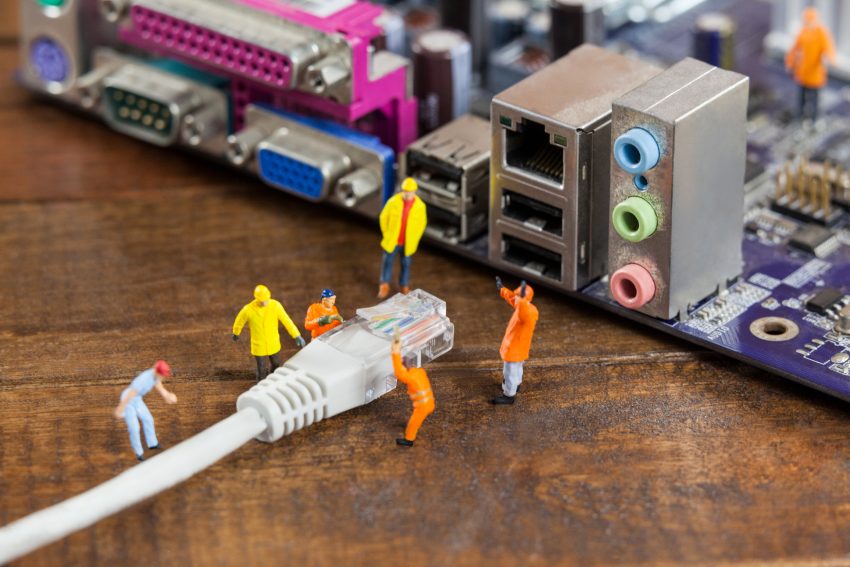A networking model provides structure and categories for both logical protocols and physical standards.
A networking protocol is a set of rules that defines how devices and software should operate and communicate logically.
OSI Model (Open Systems Interconnection)
- Created by ISO (International Organization for Standardization)
- Contains 7 layers
- Defines how data should travel from one device to another through a network
Adjacent-Layer vs Same-Layer Interaction
- Adjacent-layer interaction: communication between layers within the same device (encapsulation and de-encapsulation)
- Same-layer interaction: communication between the same layer on different devices (e.g., L7 on PC1 interacts with L7 on PC2), independent of what happens in other layers
Layer 7 – Application
- Provides process-to-process communication
- Protocols: HTTP, HTTPS
- Functions:
- Identifying communication partners (e.g., browser uses DNS to resolve a website and connect)
- Synchronizing communication (e.g., negotiating HTTP version)
- Closest layer to the end user, but does not include the applications themselves
Layer 6 – Presentation
- Prepares data from the Application layer for transmission to Layer 4
- Converts between application format and network format
- Functions:
- Format translation (e.g., PNG → JPEG)
- Coding/decoding (e.g., UTF-8 → ASCII)
- Encryption/decryption (e.g., SSL/TLS)
- Compression
- Memorize: Presentation = Preparation (Translation and Compatibility)
Layer 5 – Session
- Manages dialogues (sessions) between applications on different hosts
- A session = the time during which two programs communicate
- Functions:
- Establish, manage, and terminate sessions
- Memorize: Session = Dialogue (Time of Interaction)
Upper Layers vs Lower Layers
- Top 3 layers (L7, L6, L5) are responsible for creating/processing data
- Bottom 4 layers (L4, L3, L2, L1) are responsible for sending data
- L6 and L5 are more functional and don’t have specific protocols
- Application developers work with L5–L7
- Network engineers work with L1–L4
- Encapsulation: L7+L6+L5 produce data → L4–L2 add headers
- De-encapsulation: reverse process
Layer 4 – Transport
- Provides host-to-host (end-to-end) communication
- Protocols: TCP, UDP
- Devices: Advanced firewalls
- PDU: Segment
- Functions:
- Breaks large data into segments
- Reassembles data at the destination
- Memorize: Transport = segmentation and delivery assurance; does not change data content
Layer 3 – Network
- Provides connectivity across different networks
- Protocols: IP, ICMP
- Devices: Routers, Layer 3 switches
- PDU: Packet
- Functions:
- Logical addressing (IP)
- Path selection (routing)
- Fragmentation (if packet > MTU, usually 1500 bytes)
- Memorize: Network = Navigation using IP addresses and routing tables
Layer 2 – Data Link
- Provides node-to-node data transfer (e.g., PC → Switch → Router)
- Protocols: Ethernet
- Devices: NICs, Switches
- PDU: Frame
- Functions:
- MAC addressing
- Frame formatting
- Error detection/correction
- Memorize: Data Link = creates frames for transmission over the medium; no more encapsulation after this layer
Layer 1 – Physical
- Handles actual transmission of raw bits (electrical, optical, or radio signals)
- Defines physical characteristics: voltage, pin layout, cable specs
- Devices: Hubs
- PDU: Bit
Acronym to Memorize OSI Layers
Please Do Not Throw Sausage Pizza Away
(Physical → Data Link → Network → Transport → Session → Presentation → Application)
PDU (Protocol Data Unit) by Layer
- Layer 4: Segment
- Layer 3: Packet
- Layer 2: Frame
- Layer 1: Bit
TCP/IP Suite
- A conceptual model and set of protocols actually used in the Internet
- OSI model is typically used when talking about network architecture
- Named after two of its core protocols: TCP and IP
- Developed by DARPA
TCP/IP vs OSI Layer Mapping
| TCP/IP Layer | Corresponding OSI Layers |
|---|---|
| Application | Layer 5 Session, 6 Presentation, 7 Application |
| Transport | Layer 4 Transport |
| Internet | Layer 3 Network |
| Link | Layer 1 Physical + Layer 2 Data Link |
Note: Naming of TCP/IP layers may vary depending on the source.
📌 These are personal study notes. Please read the full disclaimer for more information.
Category: CCNA
